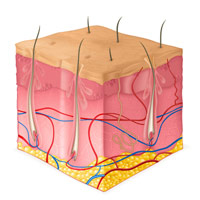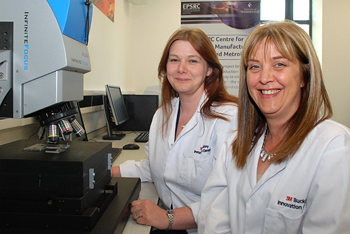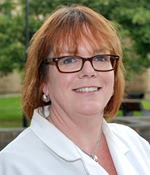Hudds launches Skin Interface Science Group
Wed, 14 Aug 2013 13:40:00 BST
Engineers, chemists, biologists and pharmaceutical scientists join health professionals for wound care research
 SCIENTISTS and healthcare experts from across the University of Huddersfield have teamed up to probe the problems of human skin. They aim to carry out research which will lead to breakthroughs in the treatment of complaints ranging from dermatitis to pressure sores that can lead to amputation in severe cases.
SCIENTISTS and healthcare experts from across the University of Huddersfield have teamed up to probe the problems of human skin. They aim to carry out research which will lead to breakthroughs in the treatment of complaints ranging from dermatitis to pressure sores that can lead to amputation in severe cases.
Engineers, chemists, biologists, pharmaceutical scientists and specialists in wound treatment are among the researchers who are pooling their expertise as members of the Skin Interface Science Group (SIS).
It is now developing collaborations with a range of companies that manufacture medical devices.
The SIS Group came together when it was realised that among the University’s lecturers and researchers there were many whose expertise was relevant to skin care problems and that discoveries could be made that would improve the quality of life for patients.
 The SIS Group is chaired by Dr Karen Ousey (seated on the right), a nurse by profession, a wound care expert and Reader in Advancing Clinical Practice at the University of Huddersfield. Dr Ousey sums up the philosophy of the group as “from bench to bed”. Starting with computer simulations, health care products can be rigorously tested before being put into production. The team are also looking at pressure redistributing devices, such as special mattresses.
The SIS Group is chaired by Dr Karen Ousey (seated on the right), a nurse by profession, a wound care expert and Reader in Advancing Clinical Practice at the University of Huddersfield. Dr Ousey sums up the philosophy of the group as “from bench to bed”. Starting with computer simulations, health care products can be rigorously tested before being put into production. The team are also looking at pressure redistributing devices, such as special mattresses.
A member of the group is Dr Leigh Fleming (seated on the left), a metrologist with the University’s EPSRC Centre for Innovative Manufacturing in Advanced Metrology. Her experience of measuring complex surfaces and their degree of roughness meant she was perfectly equipped to use her engineering knowledge to look at differences in the surface of skin.
Listen to Karen Ousey talk about the Skin Interface Science Group in more detail in this video.
“We can measure at the nano-level,” said Dr Fleming. “This means that we can examine pressure, friction and shear, which need to be prevented in order to avoid skin damage in the form of pressure ulceration.
“There are real benefits we can offer by bringing together the different disciplines to find solutions to real problems, such as reducing the incidence of pressure ulcer in patients who can’t move. We can look at how technology and science can help nurses to ensure the best possible care for patients.”
The group is some 25-strong and the wide range of disciplines included within the SIS Group means that it probably unique. Facilities in the University’s various schools and departments can be harnessed and in particular in the School of Applied Sciences, as the University’s Professor of Pharmaceutics, Barbara Conway, (pictured below) explains: “Through this collaboration, we can advance our expertise in designing and monitoring pharmaceutical formulations and specialist dressings for delivery of drugs into and through the skin.
 “We have a comprehensive range of state-of-the-art analytical and imaging equipment and in bringing together expertise from different Schools across the University, we are able to undertake high-profile, inter-disciplinary research in skin-related areas and wound care to address concerns and provide solutions to problems facing both industry and society.”
“We have a comprehensive range of state-of-the-art analytical and imaging equipment and in bringing together expertise from different Schools across the University, we are able to undertake high-profile, inter-disciplinary research in skin-related areas and wound care to address concerns and provide solutions to problems facing both industry and society.”







